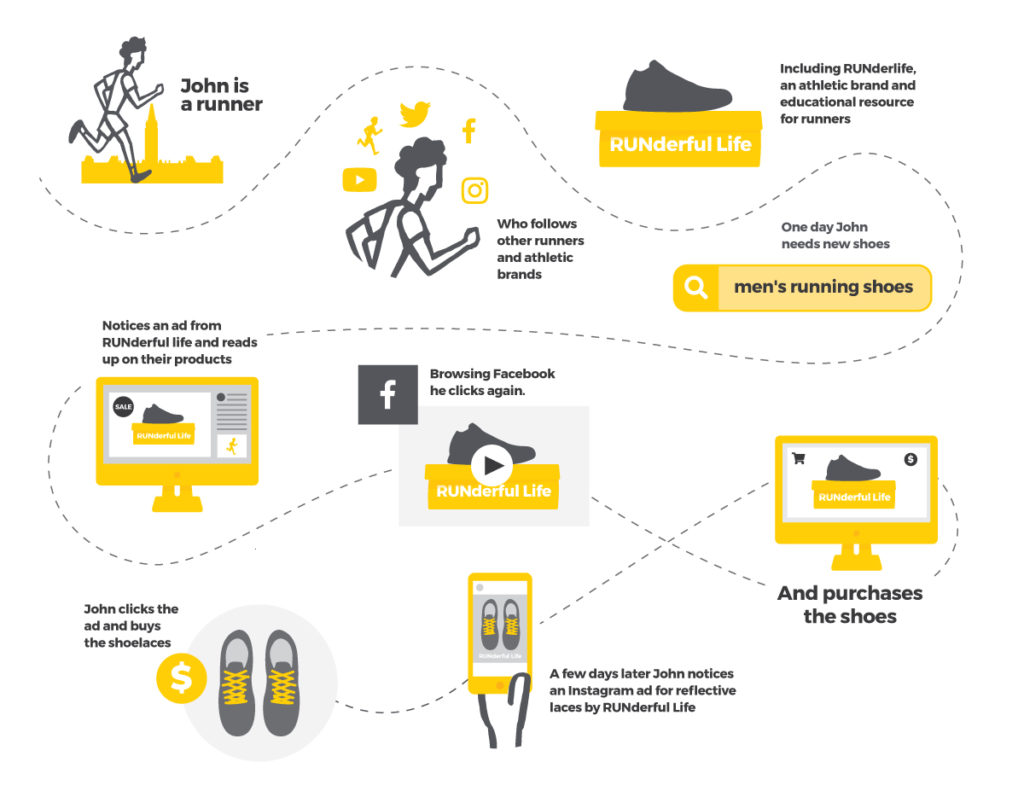digital marketing - social media
Cross Channel Marketing
“There is a place in the buyer journey for multiple platforms.”
When was the last time you bought a product or service after seeing it advertised for the first time? For most of us, we see products multiple times before we buy. We see ads on the Internet, or in magazines. We search for more information online and we see ads following us after visiting websites. Then, often times, we buy. So, if we know our consumers are actively exposed to content on multiple platforms, we should be building and executing strategies for all touch points.
Here is an example of someone moving through the buyer journey on a multi-platform experience.
Let’s set the scene:
 John is a sales rep, bacon-lover, and an avid runner living in Ottawa. After a long day of stressful work, often keeping him at the office much later than 5pm, John likes to go for an evening jog in his neighbourhood. Since running is one of his main interests, John follows a lot of sports brands on social media and is interested in learning about the latest running techniques and equipment.
John is a sales rep, bacon-lover, and an avid runner living in Ottawa. After a long day of stressful work, often keeping him at the office much later than 5pm, John likes to go for an evening jog in his neighbourhood. Since running is one of his main interests, John follows a lot of sports brands on social media and is interested in learning about the latest running techniques and equipment.
Enter a company that sells running shoes and other running equipment. Let’s call them It’s a RUNderful Life. They know that their audience is not just looking for fancy equipment, they really want to learn more about running. They produce weekly blog posts and videos that educate and entertain their audience, all on the subject of running. Their aim? To create a fanbase of loyal customers and would-be-customers that value them not just as a company, but as a resource.[/vc_column_text][vc_column_text]John realizes his running shoes have holes in them and it’s time for a new pair. He goes to Google and, after searching “men’s running shoes”, sees a number of ads promoting similar looking running shoes. He notices one of the ads is from a company he follows on social media: It’s a RUNderful Life. He clicks their paid ad promoting a sale for running shoes. He reads up on the offer, but isn’t quite ready to buy yet, so he leaves the site.
The next day, he is browsing Facebook when video ad for the same running shoes he looked at yesterday crosses his newsfeed. John is compelled to click on the ad and, finally, he buys the shoes.
A few days after his purchase, John is scrolling through his Instagram feed and notices an ad for shoelaces that are reflective in the dark and are perfect for nighttime runners. The ad shows the shoelaces being used with the running shoes that John had bought earlier in the week. He clicks on the ad and decides to buy the shoelaces.
So, what’s the advertising story behind this scenario?

First, It’s a RUNderful Life is using content marketing in addition to paid advertising. By creating frequent and consistent content, they are attracting potential customers to become familiar with their brand. They’re also keeping current customers interested and primed for future purchases. Consistent content keeps the company top of mind and builds trust with its audience.
The content marketing play works beyond social media as well. Search Engine Optimization (SEO) can play a huge role in the buyer journey. Before making a purchase how often do you Google it first?
Buyers may have identified a problem and are looking for solutions, not actual products. This is where your web content, like blogs and other resources, can help capture their attention. Instead of searching for “men’s running shoes”, John may have searched for “best men’s running shoes” first. In which case, a blog listing different shoes and their benefits would be a great way to introduce your brand to potential buyers, increase trust, and start building a retargeting audience of people who have visited your site.
In addition to organic promotion through content marketing, It’s a RUNderful Life is advertising on Google using AdWords. The company is using a retargeting audience of people who have visited their website to serve ads on Facebook. Lastly, the company has created an audience of customers on Facebook and Instagram with which to upsell and cross-sell to — like a follow up after the purchase. This is why John was served the shoelaces ad on Instagram.
By examining the buyer journey, we can pick out the best platforms and messages to reach potential customers at specific points in the buyer journey.
Content marketing can help put your business on your audience’s radar. Display ads, like GDN or Facebook videos are great ways to build awareness, especially for products or services that a user may not know they need. Search ads can help capture potential customers who are looking for what you offer.
But how does that actually work?
It may seem like magic when you start seeing ads for shoes you were thinking about last week, but the truth is that those ads are being served to you based on a very real little bit of code called a pixel.
You a pixel add to your website which sends information back to the pixel’s source, in this case Facebook and Google. The pixels can report a lot of different information that can be useful to advertisers, and not just for retargeting.
The pixel ‘fires’ (which is what we call it when the pixel sends info back to the source) when a person lands on a page, which allows us to track page visits. This is how we knew that John had visited the running shoes page, but didn’t buy. Not only can you tell what pages someone visited, you can tell what pages they didn’t visit. The pixel ‘fired’ when John his the running shoes page but since the pixel on the checkout page never fired, we know he didn’t buy the shoes. So we told Facebook to serve John (and anyone else who also visited the running shoes page but NOT the checkout page) the video ad featuring the running shoes.
Pixels allow advertising platforms like Facebook and Google to offer conversion tracking and conversion goals.
You can set up rules within the advertising platforms that tell them what a conversion is. Our video ad on Facebook could so we can see right within the Ad Manager how many conversions (purchases) the ads have generated. This is especially useful if you are split testing different ad creative — you can see which specific ad is generating the most conversions, not just link clicks.
Knowing who has converted is also useful for our retargeting rules. For our example, our video ad that features the running shoes on Facebook is served to people who view the running shoes page but don’t checkout. Obviously, once they do checkout and buy the shoes we don’t want to keep serving them ads to buy the shoes. So we can use the pixel to stop playing ads to people who have visited certain pages as well. Once John buys the shoes, he no longer sees the video ad. Then, we move John over to our cross-sell audience for the shoelaces.
While these examples are using the Facebook platform and pixel, the Google pixel works the same. Pixels and their capabilities will vary from platform to platform. The Reddit pixel doesn’t allow you to do retargeting (yet!) but it does give you information about people who have seen your ads and visited your site.
When building out your retargeting audiences, make sure to look up what the capabilities of the pixels are on the platforms you are using so you don’t get yourself into a pickle.
We’re advertising on multiple platforms, so aren’t we already doing this?
If you have the budget, you are probably already advertising on multiple channels and platforms. However, many marketers are using these channels in silos, working independently of each other. When agencies develop a true cross-channel marketing strategy, they look at the buyer’s journey across all channels and platforms and create touch points that work together.
At Alphabet, we’re constantly reviewing the best practices and ensuring we’re driving our client’s messages through the appropriate channels. This often means thinking outside the box — as we’re fond of doing — to find new ways to make new uses of a channel or platform.